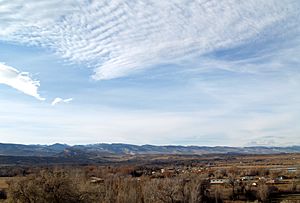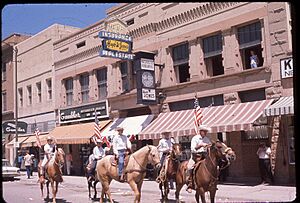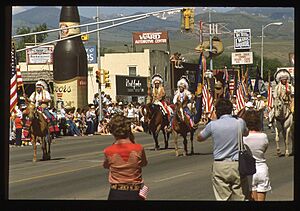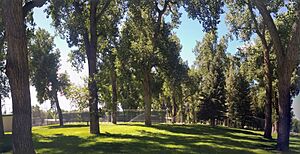Lander, Wyoming facts for kids
Quick facts for kids
Lander
|
||
|---|---|---|
|
City
|
||
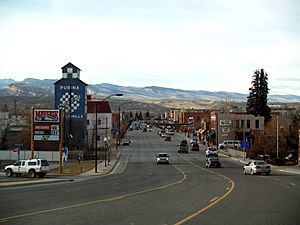
Downtown Lander, 2008
|
||
|
||
| Motto(s):
"Real. Western. Spirit."
|
||

Location of Lander in Fremont County, Wyoming.
|
||
| Country | United States | |
| State | Wyoming | |
| County | Fremont | |
| Area | ||
| • Total | 9.38 sq mi (24.30 km2) | |
| • Land | 9.38 sq mi (24.30 km2) | |
| • Water | 0.00 sq mi (0.00 km2) | |
| Elevation | 5,358 ft (1,633 m) | |
| Population
(2020)
|
||
| • Total | 7,546 | |
| • Density | 794.93/sq mi (306.92/km2) | |
| Time zone | UTC−7 (Mountain (MST)) | |
| • Summer (DST) | UTC−6 (MDT) | |
| ZIP code |
82520
|
|
| Area code(s) | 307 | |
| FIPS code | 56-44760 | |
| GNIS feature ID | 1609112 | |
Lander is a city in central Wyoming. It is also the main town, or "county seat," of Fremont County, Wyoming. You'll find it right by the Middle Fork of the Popo Agie River, just south of the Wind River Indian Reservation. Lander is a popular spot for tourists, especially with its many nearby guest ranches. In 2020, about 7,546 people lived there.
Contents
Discovering Lander's Past
Lander has had a few different names over the years, like Pushroot, Old Camp Brown, and Fort Augur. The city got its current name in 1875. It was named after General Frederick W. Lander, an explorer who mapped out a part of the Oregon Trail.
How Lander Began: The 1800s
In 1868, the Wind River Indian Reservation was officially created. Its southern border was set along the Sweetwater River. This led to more problems between the Shoshone tribe and white settlers. The settlers were moving onto reservation lands without permission.
The U.S. Government also realized that a lot of good land east of the Wind River Mountains was inside the reservation. So, in 1872, Congress allowed talks with Shoshone leaders, including Chief Washakie. These talks happened at Camp Stambaugh in the summer of 1872.
The Shoshone agreed to give up the southern part of their reservation. In return, the tribe received $25,000, $5,000 worth of cattle, and Chief Washakie got $500 a year for five years.
In 1873, The Jones Expedition explored the area where Lander would later be built. They found a route to Yellowstone National Park. They also wrote down details about hot springs, oil, and ancient carvings. The Dallas Dome area, near today's U.S. Route 287, was where Wyoming's first oil well was completed in 1883. Lander officially became a town on July 17, 1890.
Lander in the 1900s
On October 1, 1906, Lander became the end of the "Cowboy Line" railroad. This led to the slogan, "where rails end and trails begin." The railroad was supposed to go all the way to the West Coast, but it never went past Lander. Train service to Lander stopped in 1972.
When the railroad arrived, Lander's population more than doubled between 1900 and 1910. At that time, the town and valley were good for farming. People grew wool, wheat, oats, alfalfa, hay, vegetables, and fruit. However, a 1907 report said that farming in Lander only met local needs.
In 1962, U.S. Steel opened the Atlantic City iron ore mine and mill. This mine was about 35 miles south of Lander, near Atlantic City. It was a big employer in Lander. But by 1983, the mine closed down.
Lander Today: The 2000s
Lander continues to grow and change, like many small towns in the Western U.S.. Education and outdoor activities are very important to the town's economy. The Wyoming Catholic College and National Outdoor Leadership School are both based in Lander. Even though farming and mining are not as big now, Lander's population has kept growing since the year 2000.
Lander's Location and Landscape
Lander covers an area of about 4.67 square miles (12.1 square kilometers), and it's all land. The city is located in the Wind River Basin.
Sinks Canyon, which is part of the Wind River Range, is very close to Lander. In early winter, elk move from the Wind River Mountains down to the lower lands near Lander. They often stay there through the spring when their calves are born.
Lander's Climate and Weather
Lander has a climate known as a "warm-summer humid continental climate." This means it has warm summers and cold, snowy winters.
- The hottest temperature* ever recorded in Lander was 102°F (39°C) on July 27, 1935.
- The coldest temperature* ever recorded was -40°F (-40°C). This happened on December 19, 1924, and again on February 8, 1936.
| Climate data for Lander, Wyoming (Hunt Field), 1991–2020 normals, extremes 1891–present | |||||||||||||
|---|---|---|---|---|---|---|---|---|---|---|---|---|---|
| Month | Jan | Feb | Mar | Apr | May | Jun | Jul | Aug | Sep | Oct | Nov | Dec | Year |
| Record high °F (°C) | 64 (18) |
68 (20) |
76 (24) |
83 (28) |
93 (34) |
100 (38) |
102 (39) |
101 (38) |
96 (36) |
86 (30) |
72 (22) |
65 (18) |
102 (39) |
| Mean maximum °F (°C) | 51.1 (10.6) |
54.5 (12.5) |
66.7 (19.3) |
75.4 (24.1) |
83.0 (28.3) |
91.5 (33.1) |
97.0 (36.1) |
95.2 (35.1) |
88.8 (31.6) |
78.5 (25.8) |
64.4 (18.0) |
53.4 (11.9) |
97.5 (36.4) |
| Mean daily maximum °F (°C) | 32.8 (0.4) |
36.6 (2.6) |
48.6 (9.2) |
56.2 (13.4) |
66.1 (18.9) |
78.0 (25.6) |
87.7 (30.9) |
85.8 (29.9) |
74.6 (23.7) |
58.9 (14.9) |
44.3 (6.8) |
32.9 (0.5) |
58.5 (14.7) |
| Daily mean °F (°C) | 21.3 (−5.9) |
25.0 (−3.9) |
36.0 (2.2) |
43.2 (6.2) |
52.8 (11.6) |
62.8 (17.1) |
71.5 (21.9) |
69.8 (21.0) |
59.6 (15.3) |
45.4 (7.4) |
32.1 (0.1) |
21.6 (−5.8) |
45.1 (7.3) |
| Mean daily minimum °F (°C) | 9.8 (−12.3) |
13.3 (−10.4) |
23.4 (−4.8) |
30.3 (−0.9) |
39.4 (4.1) |
47.7 (8.7) |
55.2 (12.9) |
53.8 (12.1) |
44.6 (7.0) |
32.0 (0.0) |
19.9 (−6.7) |
10.2 (−12.1) |
31.6 (−0.2) |
| Mean minimum °F (°C) | −10.3 (−23.5) |
−6.1 (−21.2) |
5.5 (−14.7) |
17.2 (−8.2) |
27.5 (−2.5) |
36.8 (2.7) |
46.6 (8.1) |
44.9 (7.2) |
31.0 (−0.6) |
14.3 (−9.8) |
1.1 (−17.2) |
−10.0 (−23.3) |
−17.0 (−27.2) |
| Record low °F (°C) | −39 (−39) |
−40 (−40) |
−24 (−31) |
−11 (−24) |
13 (−11) |
25 (−4) |
32 (0) |
23 (−5) |
7 (−14) |
−14 (−26) |
−31 (−35) |
−40 (−40) |
−40 (−40) |
| Average precipitation inches (mm) | 0.51 (13) |
0.70 (18) |
1.29 (33) |
2.07 (53) |
2.68 (68) |
1.08 (27) |
0.59 (15) |
0.52 (13) |
0.98 (25) |
1.40 (36) |
0.78 (20) |
0.63 (16) |
13.23 (336) |
| Average snowfall inches (cm) | 8.2 (21) |
12.1 (31) |
14.4 (37) |
16.4 (42) |
4.5 (11) |
0.1 (0.25) |
0.0 (0.0) |
0.0 (0.0) |
1.5 (3.8) |
10.5 (27) |
10.6 (27) |
9.3 (24) |
87.6 (223) |
| Average precipitation days (≥ 0.01 in) | 4.1 | 5.4 | 5.8 | 8.4 | 9.1 | 5.9 | 4.7 | 5.0 | 5.7 | 5.9 | 4.9 | 4.3 | 69.2 |
| Average snowy days (≥ 0.1 in) | 4.3 | 5.4 | 4.7 | 5.5 | 1.8 | 0.1 | 0.0 | 0.0 | 0.6 | 3.6 | 4.4 | 4.9 | 35.3 |
| Mean monthly sunshine hours | 192.2 | 203.4 | 257.3 | 270.0 | 294.5 | 330.0 | 347.2 | 328.6 | 273.0 | 232.5 | 174.0 | 173.6 | 3,076.3 |
| Percent possible sunshine | 66.3 | 68.6 | 69.8 | 67.2 | 64.9 | 71.7 | 74.5 | 76.0 | 72.7 | 67.8 | 59.6 | 62.1 | 68.4 |
| Source 1: NOAA | |||||||||||||
| Source 2: HKO (sun only, 1961−1990) | |||||||||||||
Who Lives in Lander?
| Historical population | |||
|---|---|---|---|
| Census | Pop. | %± | |
| 1880 | 193 | — | |
| 1890 | 525 | 172.0% | |
| 1900 | 737 | 40.4% | |
| 1910 | 1,812 | 145.9% | |
| 1920 | 2,133 | 17.7% | |
| 1930 | 1,826 | −14.4% | |
| 1940 | 2,594 | 42.1% | |
| 1950 | 3,349 | 29.1% | |
| 1960 | 4,182 | 24.9% | |
| 1970 | 7,125 | 70.4% | |
| 1980 | 7,867 | 10.4% | |
| 1990 | 7,023 | −10.7% | |
| 2000 | 6,867 | −2.2% | |
| 2010 | 7,487 | 9.0% | |
| 2020 | 7,546 | 0.8% | |
| 2023 (est.) | 7,615 | 1.7% | |
| U.S. Decennial Census | |||
In 2010, there were 7,487 people living in Lander. These people lived in 3,161 households, with 1,932 of those being families. The city had about 1,603 people per square mile (619 people per square kilometer).
Most of the people in Lander (88.0%) were White. About 7.3% were Native American. Other groups made up smaller percentages. About 4.8% of the population was Hispanic or Latino.
About 28.3% of households had children under 18 living with them. The average age in Lander was 40.3 years old. About 22.4% of residents were under 18. Slightly more than half of the residents (51.0%) were female.
Lander's Economy and Jobs
Lander's economy relies on many different industries. Like the rest of Wyoming, tourism plays a big role. Outdoor recreation, healthcare, education, construction, and retail sales are major parts of the economy.
The busiest time for tourism is during the summer. Even though Lander is not right next to a major highway, the county earns a lot of money from travel-related taxes.
Many government offices are in Lander today. These include the U.S. Forest Service and the Bureau of Land Management. The U.S. Fish and Wildlife Service also has an office here. Lander is home to Eagle Bronze, a large bronze foundry. The main office for the National Outdoor Leadership School (NOLS) is also in Lander. Other non-profit groups focused on the environment are here too. These include the Wyoming Outdoor Council and The Nature Conservancy. Wyoming Catholic College is also a key part of the economy.
What Jobs Do People Have in Lander?
Here's a look at the types of jobs people had in Lander in 2017:
| Occupation | Percent of Workforce |
|---|---|
| Office & Administrative Support | 13% |
| Education, Training, & Library | 12% |
| Health Diagnosing & Treating & Other Technical | 7% |
| Construction & Extraction | 7% |
| Management | 7% |
| Installation, Maintenance, & Repair | 6% |
| Sales & Related | 6% |
| Personal Care & Service | 5% |
| Food Preparation & Serving | 5% |
| Building & Grounds Cleaning & Maintenance | 4% |
| Community & Social Service | 3% |
| Healthcare Support | 3% |
| Transportation | 3% |
| Production | 3% |
| Life, Physical, & Social Science | 2% |
| Material Moving | 2% |
| Business & Financial Operations | 2% |
| Health Technologists & Technicians | 1% |
| Architecture & Engineering | 1% |
| Arts, Design, Entertainment, Sports, & Media | 1% |
| Law Enforcement Workers | 1% |
| Legal | 1% |
| Fire Fighting & Prevention, & Other Protective Service Workers | 1% |
| Farming, Fishing, & Forestry | 1% |
News and Entertainment in Lander
Here are some ways people in Lander get their news and listen to music:
Local News: Print and Online
- Lander Journal
- Wyofile
- County 10
- Lander Talk
Local Radio Stations
- KLDY 97.5 FM
- KOVE - 1330 AM
Arts, Culture, and Fun Events
Lander has a lively arts and culture scene. The Lander Art Center downtown shows different art exhibits. It also holds art fairs twice a year and offers various art classes. The William Shakespeare plays are performed by the Wyoming Shakespeare Festival Company, which is based in Lander. Since 1947, the Lander Community Concerts Association has brought in many performing artists. Lander's main library is part of the Fremont County Library System. The original Carnegie library building is still part of the current library.
The town is also one of the headquarters for Asthmatic Kitty Records, a music label started by Sufjan Stevens.
Yearly Celebrations and Festivals
- Pioneer Days Parade and Rodeo: This event happens every year on July 3rd and 4th.
- Lander Brew Festival: Since 2002, this festival has featured samples from breweries in the Rocky Mountain area.
- Wyoming State Winter Fair: This fair includes livestock shows and rodeo activities.
- Other yearly events include the International Climbers Festival and the Annual One Shot Antelope Hunt.
Places to Visit and Explore
Near Lander, you can enjoy outdoor attractions like Sinks Canyon State Park, Worthen Meadow Reservoir, Shoshone National Forest, the Wind River Mountains, and the Red Desert.
Lander also has several museums:
- Fremont County Pioneer Museum: This museum focuses on the history of the Lander area.
- Museum of the American West: This museum has a collection of historic buildings.
- Sacagawea Cemetery: This cemetery is near Fort Washakie, about 15 miles north of Lander. It's on the Wind River Indian Reservation.
- Lander Children's Museum: This museum has hands-on exhibits for kids.
- Evans Dahl Memorial Museum: This museum is dedicated to the Annual One Shot Antelope Hunt.
Several places in Lander are listed on the National Register of Historic Places. These include the Lander Downtown Historic District and the US Post Office and Courthouse-Lander Main.
Education in Lander
Public Schools
Public education in Lander is managed by Fremont County School District #1.
- Lander Valley High School is the main high school.
- Pathfinder is an alternative high school.
National Outdoor Leadership School (NOLS)
The National Outdoor Leadership School (NOLS) was started in Lander, and its main office is still here. Their Rocky Mountain branch also operates from Lander. NOLS uses the Noble Hotel on Main Street for its instructors, students, and former students.
Wyoming Catholic College
In 2007, Wyoming Catholic College was founded in Lander. It's a four-year, private college for both male and female students. It was only the second four-year college built in Wyoming. The college focuses on a broad education using a "Great Books" curriculum. It also helps students grow morally and spiritually in a small Catholic community.
The college has an Outdoor Adventure Program. This program takes students into the nearby Wind River Mountains. Here, they learn leadership and decision-making skills. The college received full accreditation in 2019.
City Services and Transportation
Postal Service
The United States Postal Service runs the Lander Post Office.
Airports
Lander has a small airport for general aviation called Hunt Field. If you need scheduled passenger flights, you can go to the Central Wyoming Regional Airport near Riverton, Wyoming.
Law Enforcement
The Lander Police Department is in charge of law enforcement within the city.
Famous People from Lander
Many interesting people have connections to Lander:
- Jim Allen (born 1952), a former member of the Wyoming House of Representatives, was born in Lander.
- Keri Ataumbi (born 1971), a Kiowa artist, was born near Lander on the Wind River Indian Reservation.
- Steve Bechtel (born 1970), a rock climber known for many first climbs, lives and works in Lander.
- Cale Case (born 1958), an economist, businessman, and politician, was born in Lander.
- Mike Dabich (born 1942), a professional basketball player, played one season in the American Basketball Association.
- Clayton Danks (1879–1970), the model for the cowboy on Wyoming's state trademark, is buried in Lander.
- Ed Drew (1865–1911), born in Lander, was an Arizona rancher, miner, and lawman.
- Teri Greeves (born 1970), a Native American beadwork artist, was born near Lander on the Wind River Indian Reservation.
- Lester C. Hunt (1892–1954), the 19th governor of Wyoming and a U.S. Senator, was known for opposing Senator Joseph McCarthy.
- Ralph Kimball (1878–1959), a former Justice of the Wyoming Supreme Court, lived in Lander as an adult.
- Larry LaRose (born 1953), a NASA flight engineer, is from Lander.
- Nate Marquardt (born 1979), a mixed martial artist in the UFC, was born in Lander.
- Barney McLean (1917–2005), an alpine skier who competed in the 1948 Winter Olympics, was born in Lander.
- Joseph B. Meyer (1941–2012), Wyoming attorney general and state treasurer, worked as an assistant county attorney in Lander early in his career.
- Helen Mowery (1922-2008), Miss Wyoming 1939 and an actress, was raised in Lander.
- Bob Nicholas (born 1957), a Wyoming State representative, is from Lander.
- Phil Nicholas (born 1955), a Republican member of the Wyoming Senate, was born in Lander.
- Sacagawea (c. 1788–c. 1884), from the Lemhi Shoshone tribe, helped Lewis and Clark on their journey.
- Todd Skinner (1958–2006), a free climber, lived in Lander to be close to its cliffs.
- Guy Trosper (1911–1963), a screenwriter, was born and is buried in Lander.
- Seth Brady Tucker (born 1969), a poet, was born in Lander.
See also
 In Spanish: Lander (Wyoming) para niños
In Spanish: Lander (Wyoming) para niños




